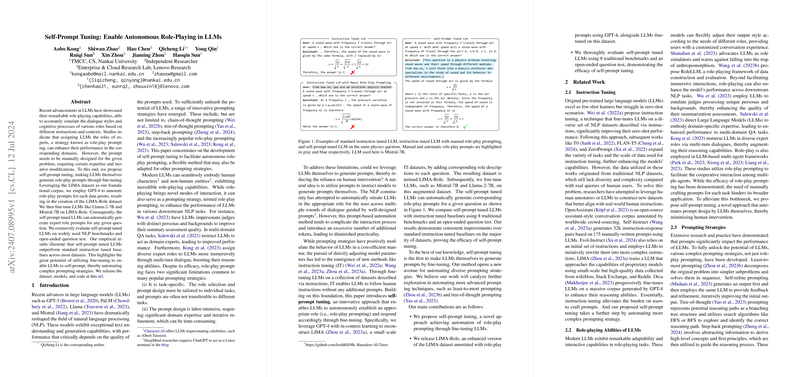The paper "Self-Prompt Tuning: Enable Autonomous Role-Playing in LLMs" introduces a novel technique for enhancing the autonomous role-playing capabilities of LLMs by allowing them to generate their own role-play prompts through a process termed self-prompt tuning. The core idea is to enable the LLMs to simulate expert roles effectively without manual prompt engineering, which typically requires significant expertise and iterative refinement.
Overview
- Problem Context: Role-play prompting, where LLMs simulate domain-specific experts, has proven effective in improving model performance across various tasks. However, designing such prompts manually is task-specific and resource-intensive.
- Solution Approach: Self-prompt tuning is proposed as a method where LLMs are fine-tuned to generate role-play prompts automatically. This approach leverages fine-tuning strategies akin to instruction tuning but incorporates self-generation of prompts.
- Dataset and Methodology:
- The LIMA dataset serves as the base, extended with role-play annotations generated using GPT-4, resulting in the new LIMA-Role dataset.
- LLM models such as Llama-2-7B and Mistral-7B are fine-tuned on this LIMA-Role dataset. The process involves structuring the data as user-AI Assistant interactions, with predefined system prompts outlining roles.
Contributions and Empirical Evaluation
- Contributions:
- Introduction of self-prompt tuning to automate role-play prompting, which reduces human intervention in prompt design.
- Creation and release of the LIMA-Role dataset with role descriptions for fine-tuning LLMs.
- Demonstrated that self-prompt tuned LLMs perform better than standard instruction-tuned models across multiple NLP benchmarks.
- Evaluation: The effectiveness of self-prompt tuning is validated across:
- NLP Benchmarks: Improved performance over baselines was observed across multi-domain QA datasets like MMLU, StrategyQA, and single-domain tasks like HumanEval and GSM8K.
- Open-ended Questions: On a test set of challenging, open-ended questions, LLMs with self-prompt tuning performed better compared to those solely instruction-tuned on LIMA.
- Key Findings:
- Self-prompt tuned models show substantial improvements in generating context-appropriate role-play prompts compared to traditional instruction-tuned models.
- These improvements are consistent across most but not all evaluated datasets, indicating the technique's potential for broad application but also suggesting areas for further refinement and tuning.
Limitations and Future Directions
- Data Scale: LIMA-Role, being limited in scale, may not be entirely sufficient for fine-tuning models with larger parameters, potentially impacting the comparative efficacy against larger, more complex models.
- Prompt Design Sensitivity: The paper finds that even fine-tuning prompt designs can influence model performance, albeit not as pronouncedly as in zero-shot or few-shot scenarios, highlighting areas for optimization.
- Future Work: Extending this methodology to other forms of complex prompting strategies, such as least-to-most prompting or tree-of-thought prompting, remains an open avenue for exploration.
In summary, self-prompt tuning offers a promising approach to automating role-play with LLMs, streamlining the prompt design process, and improving model adaptability and effectiveness in role-specific tasks without extensive manual input.
